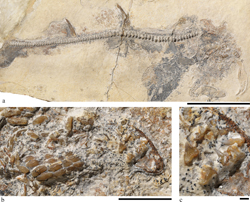Research Interests
|
My research focuses on the evolutionary radiation and diversity of cartilaginous fishes with special focus on the origin and success of modern sharks, skates and rays (Neoselachii). I use different analytical methods to explain the shapes of phylogenies, quality of the fossil record, diversification, extinction and biogeographic patterns and trophic chain conditions and changes. |
|
|
|
Novelties and phylogeny in the evolutionary radiation of modern sharks and rays
In this project I have identified and reconstructed evolutionary novelties in neoselachians employing numerical comparative phylogenetic methods for providing sound information on the initial radiation of this group and evaluated the evolutionary steps cumulating in a perfectly adapted predator.
Funding: European Union FP7, Marie Curie Research Fellowship |
 |
up |
|
|
|
Stem-lineage neoselachians - the Synechodontiformes
Our understanding of early neoselachian diversities and systematics are still very inadequate. Among the wide array of fossil taxa reported from the Mesozoic is one group of sharks, traditionally assigned to Synechodontiformes, which includes abundant taxa mostly based on isolated teeth. Although ranging from the Permian to the Thanethian and reported from both hemispheres, they are a largely disregarded group of early modern sharks, whose importance for the evolution of neoselachians was mostly unrecognized. My PhD thesis focused on the taxonomy, and inter- and intrarelationships of these sharks. Most important results are that Synechodontiformes are a monophyletic group representing the neoselachian stem-lineage. Accordingly the origin of modern sharks and rays can be traced back to the Permian.
Funding: Synthesys, RBINS research fellowship |
 |
up |
|
|
|
Environmental controls and distribution of Late Jurassic neoselachians from the Iberian Peninsula in the European context
This project focuses on Late Jurassic neoselachians from NE Spain and Portugal assessing the palaeoenvironmental distribution of sharks and rays within the Iberian Peninsula but also to reconstruct faunal exchanges between European Late Jurassic neoselachian faunas and discriminate tethyal and boreal influences. Geochemical tracer analyses (δ18O, 87Sr/86Sr) performed on selected teeth from a range of different facies and ages will help establishing a stratigraphic and palaeoecological framework. The results will be compared to other Late Jurassic neoselachian assemblages and general diversity patterns will be reconstructed, which, in turn, can be used as proxies for modern neoselachian distribution.
Collaboration: Juergen Kriwet, Stefan Hölzl
Funding: German Scientific Foundation (DFG)
|  |
up |
|
|
Anatomy and taxonomy of Late Jurassic neoselachians
Late Jurassic neoselachians from the Lithographic Limestones of southern Germany are exceptional because of their preservation as partial or complete skeletons. These specimens provide detailed information of morphological traits of apparently plesiomorphic taxa and establish an informative dataset for comprehensive phylogenetic analyses.
Collaborations: Juergen Kriwet, Ronald Boettcher, Detlev Thies
Funding: Synthesys, German Scientific Foundation (DFG) |
 |
up |
|
|
|
Sexual and ontogenetic dimorphism in neoselachians
According to the high abundance of fossil shark teeth in the fossil record, some sort of odontological para-taxonomy has been established in the last decades. However, recent studies of skeletal remains of extinct neoselachians and extant forms assume that sexual and ontogenetic dimorphisms also in teeth is more abundant in neoselachians than previously assumed. The aim of this project is to analyse those taxa, which might present sexual and/or ontogenetic differences resulting in different skeletal and tooth taxonomies to contribute to the completeness of the fossil record and establishing a taxonomic scheme based on apomorphic characters.
Funding: Synthesys |
 |
up |
|
|
|
Clasper morphology of extant and extinct sharks
This project is dedicated at evaluating characters of the clasper organs of extinct and extant sharks for taxonomic and systematic purposes.
|
 |
up |
|
|
|
Diversity patterns of Mesozoic neoselachians
The aim of this project is to analyse faunal compositions and diversity fluctuations of neoselachians throughout the Mesozoic and to establish their diversity, migratory, and biogeographic patterns during crucial periods (e.g., Jurassic-Cretaceous boundary).
Collaborations: Juergen Kriwet, Mike Benton, Wolfgang Kiessling |
 |
up |
|
|
|
Phylogeny of neoselachians - a multidisciplinary approach
The aim of this project is to re-evaluate the phylogeny of living and fossil neoselachians using molecular, skeletal and dental characters, and to analyse the value of skeletal characters in establishing a comprehensive phylogeny including extant and extinct taxa.
Collaboration: Juergen Kriwet |
 |
up |
|
|
|
South-east Asia
This project focuses on the taxonomy, systemtics and evolution of cartilaginous and bony fishes from the Jurassic to the Holocene of SE-Asia. A first field-trip to Java and Sulawesi was undertaken in autumn 2008 to assemble data and material including tissue samples of extant sharks, rays and skates.
Collaboration: Juergen Kriwet, Matthias Glaubrecht, Johan Arif
Funding: German Scientific Foundation (DFG)
|
 |
up |
|
|
